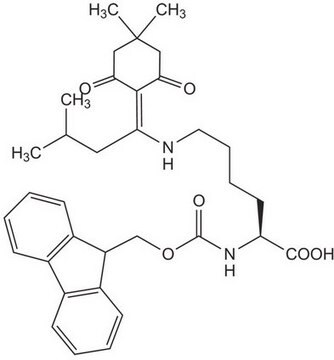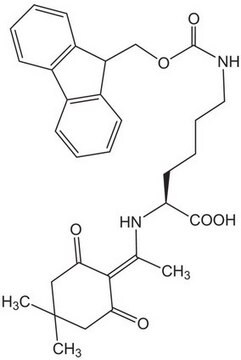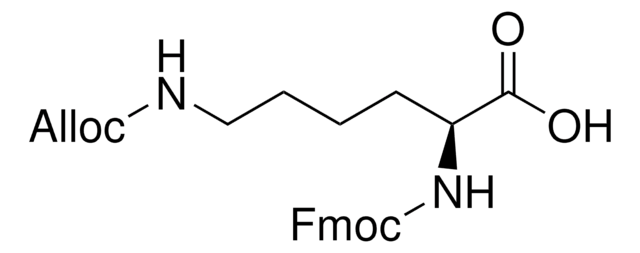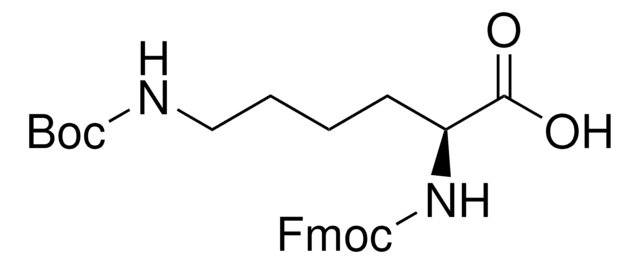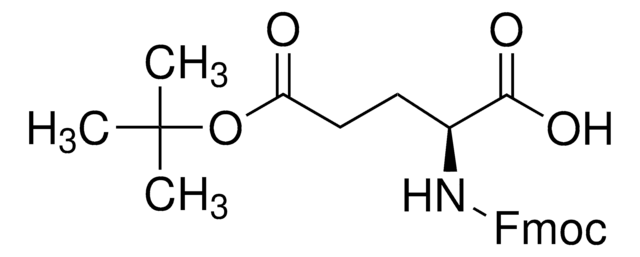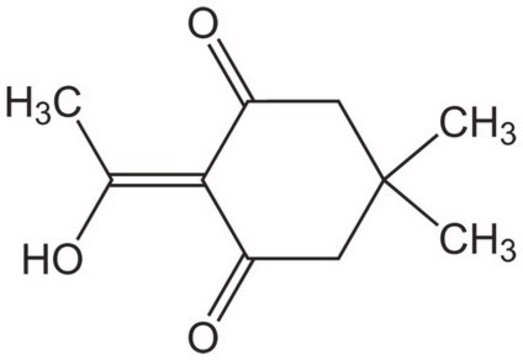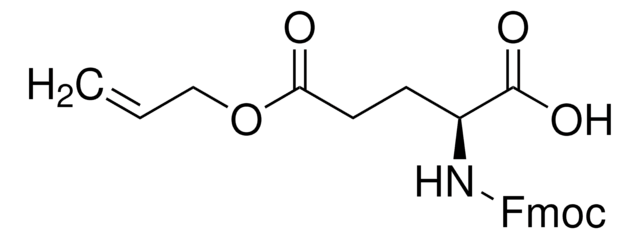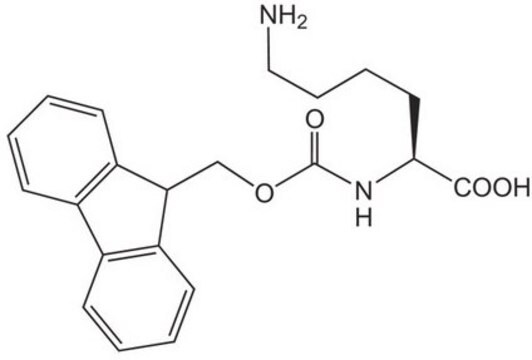8.52057
Fmoc-Lys(Dde)-OH
≥98% (TLC), for peptide synthesis, Novabiochem®
Sinónimos:
Fmoc-Lys(Dde)-OH, N-α-Fmoc-N-ε-1-(4,4-dimethyl-2,6-dioxocyclohex-1-ylidene)ethyl-L-lysine
About This Item
Productos recomendados
product name
Fmoc-Lys(Dde)-OH, Novabiochem®
Nivel de calidad
Línea del producto
Novabiochem®
Análisis
≥90.0% (acidimetric)
≥97.0% (HPLC)
≥98% (TLC)
formulario
powder
idoneidad de la reacción
reaction type: Fmoc solid-phase peptide synthesis
fabricante / nombre comercial
Novabiochem®
mp
80 °C (decomposes)
aplicaciones
peptide synthesis
grupo funcional
amine
temp. de almacenamiento
15-25°C
InChI
1S/C31H36N2O6/c1-19(28-26(34)16-31(2,3)17-27(28)35)32-15-9-8-14-25(29(36)37)33-30(38)39-18-24-22-12-6-4-10-20(22)21-11-5-7-13-23(21)24/h4-7,10-13,24-25,34H,8-9,14-18H2,1-3H3,(H,33,38)(H,36,37)/t25-/m0/s1
Clave InChI
AOHSSQNORWQENF-VWLOTQADSA-N
Descripción general
Associated Protocols and Technical Articles
Cleavage and Deprotection Protocols for Fmoc SPPS
Literature references
[1] B. W. Bycroft, et al. (1993) J. Chem. Soc., Chem. Commun., 778.
[2] B. Rohwedder, et al. (1998) Tetrahedron Lett., 39, 1175.
[3] N. Ahlborg (1995) J. Immun. Meth., 179, 269.
[4] B. W. Bycroft, et al. in ′Peptides, Chemistry, Structure & Biology, Proc. 13th American peptide Symposium′, R. S. Hodges & J. A. Smith (Eds), ESCOM, Leiden, 1994, pp. 727.
[5] J. Mack, et al. (2001) J. Peptide Sci., 7, 338.
[6] G. B. Bloomberg, et al. (1993) Tetrahedron Lett., 34, 4709.
[7] P. Dumy, et al. (1995) Tetrahedron Lett., 36, 1255.
[8] J. Eichler, et al. (1994) Pept. Res., 7, 300.
[9] C. G. Fields, et al. (1993) Biopolymers, 33, 1695.
[10] H. F. Brugghe, et al. (1994) Int. J. Peptide Protein Res., 43, 166.
[11] P. Hoogerhout, et al. (1995) Infection & Immunity, 63, 3473.
[12] D. Lelievre, et al. (1995) Tetrahedron Lett., 36, 9317.
[13] P. Hoogerhout, et al. (1999) J. Peptide Res., 54, 436.
[14] P.J. Conolly, et al. (2000) Tetrahedron Lett., 41, 5187.
[15] K. Augustyns, et al. (1998) J. Peptide Res., 51, 127.
[16] A. Srinivasan, et al., Poster 111 presented at the 15th American Peptide Symposium, Nashville, 1997.
[17] S. Peluso, et al. (1999) J. Org. Chem., 64, 7114.
[18] J. J. Diaz-Mochón, et al. (2004) Org. Lett., 6, 1127.
Ligadura / enlace
Nota de análisis
Appearance of substance (visual): powder
Identity (IR): passes test
Enantiomeric purity: ≥ 99.5 % (a/a)
Purity (TLC(157B)): ≥ 98 %
Purity (TLC(CMA2)): ≥ 98 %
Assay (HPLC, area%): ≥ 97.0 % (a/a)
Solubility (1 mmole in 2 ml DMF): clearly soluble
Assay (acidimetric): ≥ 90.0 %
Water (K. F.): ≤ 1.0 %
To see the solvent systems used for TLC of Novabiochem® products please click here.
Información legal
Código de clase de almacenamiento
11 - Combustible Solids
Clase de riesgo para el agua (WGK)
WGK 2
Punto de inflamabilidad (°F)
Not applicable
Punto de inflamabilidad (°C)
Not applicable
Certificados de análisis (COA)
Busque Certificados de análisis (COA) introduciendo el número de lote del producto. Los números de lote se encuentran en la etiqueta del producto después de las palabras «Lot» o «Batch»
¿Ya tiene este producto?
Encuentre la documentación para los productos que ha comprado recientemente en la Biblioteca de documentos.
Artículos
Novabiochem® product range has one of the largest collections of orthogonally and quasi-orthogonally protected tri-functional amino acids. These derivatives are useful tools for the synthesis of cyclic and branched peptides and peptides carrying side-chain modifications.
Nuestro equipo de científicos tiene experiencia en todas las áreas de investigación: Ciencias de la vida, Ciencia de los materiales, Síntesis química, Cromatografía, Analítica y muchas otras.
Póngase en contacto con el Servicio técnico